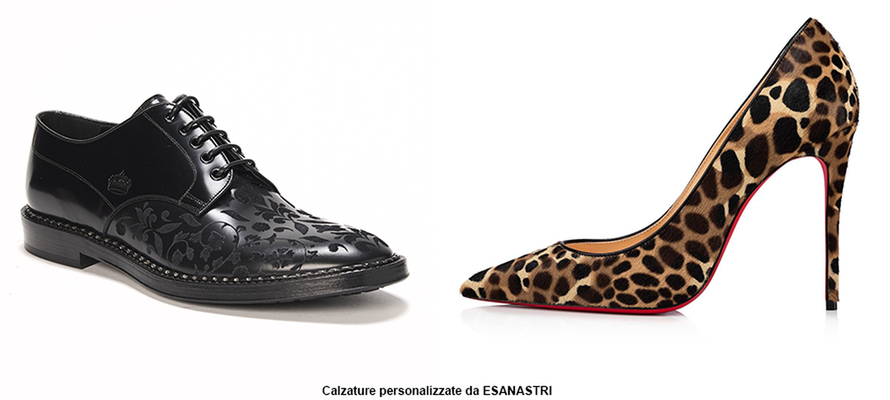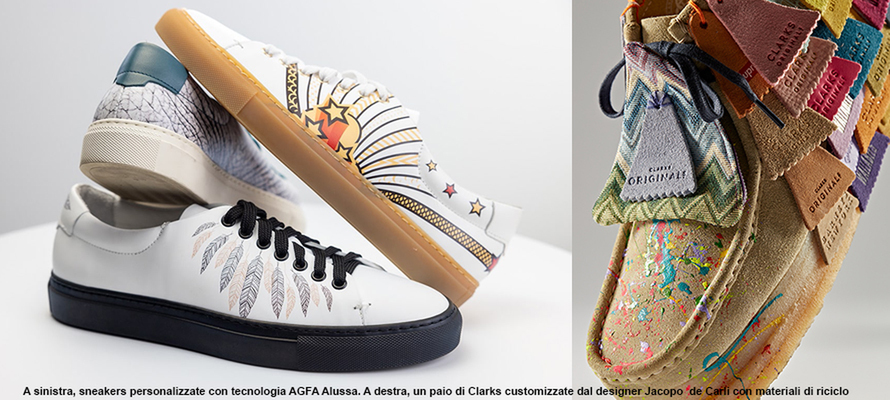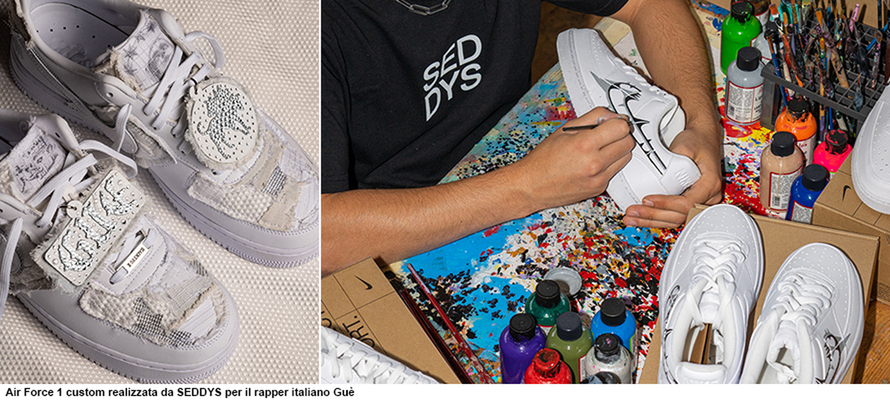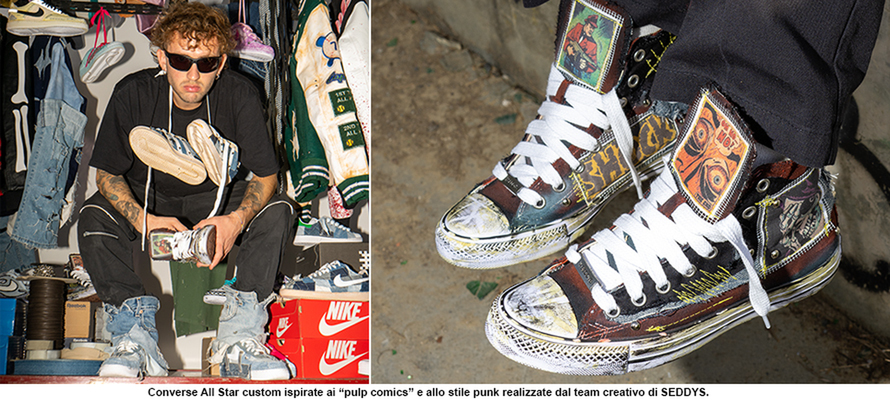A shoe of one's own
The phenomenon of extreme customisation has also infected the world of footwear - in particular sneakers, which, thanks to the combination of technology, innovative materials and creative collaborations, has become a means of expression with extremely high potential. We talked about this with Dieter Jancart (Agfa), Nicola Posarelli (Esanastri), Paolo Organo and Massimiliano Klimciuk (Canon Italia), Marco Serughetti (SEDDYS) and Jacopo de Carli (DJC).
By Caterina Pucci | On PRINTlovers 103
“There was a time in New York when all you had to do to understand who you were was look at your feet. It was a way of saying: this is me”. This was said by Doze Green, one of the pioneers of hip-hop culture, who sums up in a few words the meaning of what has for years been defined as “sneaker culture”: a cultural phenomenon that has seen the classic rubber-soled shoe transcend its original function as a sports shoe to become a tool for personal expression, through which to assert one's stylistic identity, on a par with other items of clothing such as jeans and T-shirts. According to predictions, the sneakers market will reach a value of $120 billion by 2026. Looking at the reselling segment alone, it is estimated that the US sneaker reselling market will grow from $2 billion to as much as $30 billion by 2030. A large part of this success is dictated by the change of pace during the pandemic, which has led to more and more consumers preferring comfortable clothing, resulting in an increase in athleisure sales. At the same time, haute couture brands have increased their collaborations with sports brands, resulting in limited editions that sell out within hours of release. The demand for extreme customisation has also led to the emergence of made-to-order platforms - think of “Nike By You” - where customers can choose model, colour, upper, print and follow the creation of their dream shoe step by step. In this context, introducing increasingly high-performance printing technologies on leather and fabric and developing innovative materials have proven crucial in meeting new consumer demands.
The challenge of digital printing on leather
The introduction of ink-jet printing in the footwear industry has reduced start-up costs to zero, allowing brands to quickly and easily produce one-offs or larger runs at the same cost per copy without having to redesign the shape of the individual accessory. “By researching the leather and fashion industry, we found that the demand for more exclusive items and faster iterations of collections has become a huge issue for brands,” explains Dieter Jancart, Segment Manager High End Systems DPS at Agfa. “One of the critical issues with printing on leather is that it is not a standardised material: each batch can have differences, which can affect the quality and yield of the finished product. Traditionally, tanners finish their products with polyurethane to protect the leather and give it specific characteristics such as softness, fullness, colour rendering, buffability and mechanical resistance. Applying a print on tanned leather can lead to cracking and peeling of the printed layer. To overcome this problem, Agfa has spent years researching the tanning process to understand how to adapt its printing process without compromising the characteristics and quality of the leather. “The fruit of this R&D work is the Alussa technology, in which the ink chemistry has been adapted to work in harmony with the chemicals used in the leather production process. The main challenge is approaching a world such as the tannery, which has very different characteristics from the printing industry so that it can embrace the advantages of a new type of technology and new skills”.
Screen printing or digital? It depends on the final effect
The choice of printing technique, screen or digital, depends on the type of substrate to be decorated - whether leather or fabric - and the desired effect. Digital allows you to use multiple colours and shades and to obtain tiny details. Screen printing allows you to achieve special effects (metallic, pearlescent, glitter, flocked, embossed) but requires more complex pre-press preparation involving films and frame engraving. “We work with fashion brands, shoe factories, tanneries, always trying to create a synergy with the customer to satisfy their requests,” explains Nicola Posarelli, owner of Esanastri, “which vary significantly according to seasonal trends, even if in recent years the Animalier has dominated the footwear and clothing market. Leather goods follow slightly different dictates: customisation is more evident even with logos combined with effects such as lamination and clicks”.
The combination of technologies and materials
It has to be said that the tanning world - by its very nature inclined to innovation - started to introduce different printing techniques at an early stage, proceeding by trial and error. Each tanning company has thus developed its own “secret recipe”.
“Technology manufacturers must collaborate closely with material manufacturers to develop solutions that meet the needs of different markets. For Canon, which has made mass customisation and the Total Experience its leitmotiv, the opportunity came through a partnership with a major Italian company specialising in creating digital printing substrates. Working in synergy, we have developed a range of leather-look substrates for a wide range of applications, from fashion accessories to furnishing accessories,” explains Paolo Organo, Product Marketing Manager of Canon Italia.
The possibility of modifying the polyurethane mixture so that the substrate would perfectly adapt to Canon’s UVgel printing technology has allowed the company to develop five different proposals with different finishes (smooth, dollar, orange peel or skin) and treatments (such as the super popular flame retardant) that suit different market segments. “In the fashion sphere, there is still some resistance because each company seeks a uniqueness that a line of standardised materials does not allow,” explains Massimiliano Klimciuk, Sales Manager, Business Development Imaging Supplies of Canon Italia. “In the contract field at the moment, the opportunities are greater because companies work on standardised production lines, and the introduction of substrates like ours helps designers and architects to create a guide, simplifying the creative processes.”
Customising a shoe: from design to finished product
SEDDYS is one of the first Italian companies to have started a customisation business on sneakers. The project originated in 2014 from the passion of the two founders, both from the artisan production/crafting of accessories, who began by customising almost exclusively Converse and Vans with studs and applications. Today, SEDDYS is a custom design studio, which, thanks to continuous research into technical innovations, design and style trends and attention to materials, allows it to create models made to measure for the customer, as well as propose seasonal collections that follow the trends of the moment without losing their stylistic identity.
“The entire creative process takes place in our lab: first, we select the most popular sneaker models from major brands, including Nike, Adidas, Asics, Converse and New Balance. We start by searching for “references”, meaning all those references to culture, music and fashion that inspire our creations. From hip-hop culture to skate aesthetics, from DIY workmanship reflecting a punk soul to a rebellious and unconventional attitude, all these elements make us recognisable as a brand and unique in the Italian custom scene,” explains Marco Serughetti, creative director of SEDDYS.
The custom design is planned on the basis of the chosen silhouette; for example, on a Nike trainer, the swoosh - the iconic logo, often hand-painted or covered in fabric - is considered. We then move on to the choice of materials, techniques and tools to produce the customisation: from hand-painting to the use of airbrush, from the use of fabrics sewn onto the sneaker to the application of studs, pearls and crystals, from digital printing to dyes.
“Digital printing is the most widely used technology, with different machinery depending on the type of fabric being customised. So we can recreate on fabric patches - then sewn onto the sneakers or clothing - any image and writing, even on shoe areas such as the tongue that cannot be painted by hand”. Products made with this printing technique include the Nike Dunk Premium dedicated to GTA San Andreas, with quotations and symbols from the videogame, and the words “San Andreas” and “Los Santos” made with digital printing and stencils. Or the Nike Air Force 1 designed for the Italian rapper Guè with printed fabric patches covering the trainer's tongues with the symbols of Milan (the biscione and the Madonnina) imprinted on them. The same process was applied to another special project, the Clarks Wallabees dedicated to the Wu-Tang Clan, made for the 30th anniversary of the album “Enter the Wu-Tang”, whose cover was printed and stitched on the tongues. In addition to these special projects, digital is also a technique used on models of the seasonal collections, which are available both on the SEDDYS website and in the stores with which they collaborate. “Our customers’ requests vary greatly depending on the season, the trends of the moment and the individual person's tastes. Among the most popular customisations in the last season, there are definitely the dyes, both with a shaded effect in double shades like our Adidas Samba 2Dye and monochrome. Comics - a comic-book effect obtained through hand-painting, combined with the season's shaded colours - also remain an evergreen. One of the trends that has accompanied us throughout last year and will continue throughout 2024 is denim: we use high-quality recycled jeans for our custom designs in an upcycling approach.”
Creative restoration, recovery of craftsmanship
As in other segments of the fashion world, the concept of upcycling - creative reuse aimed at giving new life to an object, transforming it into a product of higher quality, real or perceived - has also become widespread in the footwear sector. Among the best-known Italian sneaker restorers is Jacopo de Carli, who works with a “conservative” approach to keep the material and the shoe’s original condition as unchanged as possible. “It’s similar work to what is done on a painting, to clean up the canvas without compromising it, trying to preserve its original state and enhance its flaws. In the end, precisely these imperfections are what constitute the real added value for the collector,” explains de Carli. His past as a shoemaker has allowed him to apply treatment techniques typical of classic footwear to sneakers, too, using cleaning products with a specific pH to improve the performance on a particular type of leather, working on improving the sole and adding accessories.
Tailor-made customisations, innovative product lines for shoe care, exclusive events and workshops - among the most recent being the one at Miami Art Basel - have made him a point of reference in the field of sneaker culture and have led to the creation of custom models for companies such as Clarks or Birkenstock, often made from stock scraps. “Restoration is still a niche, but it emphasises how increasingly important it is for brands and designers to recover the more artisanal sense of the product they sell, no longer interfacing just with influencers but rather with artisans, the people who master the secrets of this art and can restore a greater sense of authenticity to the consumer”.






